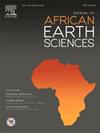加纳城市热岛的时空土地利用/土地覆被变化分析与评估:聚焦大阿克拉地区
IF 2.2
4区 地球科学
Q2 GEOSCIENCES, MULTIDISCIPLINARY
引用次数: 0
摘要
多年来,随着城市的扩张和经济的发展,许多地方都变成了聚集大量城市人口的热点地区。加纳首都大阿克拉地区也不例外。该地区的城市人口增长率以植被覆盖率的不断增加为代价而大幅增长。因此,对该地区的城市恢复力、土地利用/土地覆盖(LULC)变化和城市热岛(UHI)动态进行研究的需求日益增加。本研究旨在分析 2000 年和 2020 年的多光谱大地遥感卫星图像,以研究加纳大阿克拉地区的土地利用/土地覆被变化和城市热岛趋势。分析结果表明,2000 年至 2020 年间,陆地表面温度(LST)的空间趋势和 UHI 发生了显著变化。在 2000 年和 2020 年,地表温度的空间分布分别为 0 ℃ 至 28 ℃ 和 17 ℃ 至 33 ℃。到 2020 年,城市地区占研究区域的一半以上,占 85%(相当于 3160 平方公里),比 2000-2020 年增加了 20%。同期,疏林区和密林区分别减少了 10%(373 平方公里)和 4%(146 平方公里),裸地减少了 5%(相当于 177 平方公里)。时空分析表明,研究区域内的城市人口显著增加。UHI 区域也从 2000 年的 13.20% 增加到 2020 年的 18.20%。另一方面,同期非 UHI 地区从 86.80% 下降到 81.80%。这项研究的成功证明了空间模型作为生成土地利用、土地利用变化和气候地图的工具,在评估超高温影响以促进未来可持续城市规划方面的实用性。本文章由计算机程序翻译,如有差异,请以英文原文为准。
Spatio-temporal land use/land cover change analysis and assessment of urban heat island in Ghana: A focus on the Greater Accra Region
The expansion of cities coupled with economic development over the years has transformed many locations into hotspots for massive urban populace. The Greater Accra Region which is the capital city of Ghana is no exception. The urban population growth rate in the region has expanded extensively at the expense of increasingly vegetation cover. As a result, there is an increasing need to investigate urban resilience, land use/land cover (LULC) change, and urban heat islands (UHI) dynamics in the region. The aim of this study is to analyze multi-spectral Landsat images of 2000 and 2020 to examine the LULC change and the UHI trend across the Greater Accra Region of Ghana. The results from the analysis show a significant change in the spatial trend of land surface temperature (LST) and UHI between the years 2000 and 2020. Spatial distribution of LST from 0 °C to 28 °C and 17 °C–33 °C in the years 2000 and 2020 respectively were observed. Urban areas dominated more than half of the study area in 2020, covering 85% (equivalent to 3160 sq. km), and reflecting a 20% increase from the year 2000–2020. During the same period, sparse and dense forested areas decreased by 10% (373 sq. km) and 4% (146 sq. km) with a 5% reduction in bare land (equivalent to 177 sq. km). The spatio-temporal analysis revealed a significant surge in the population of urban areas within the study area. The UHI areas also increased from 13.20% in 2000 to 18.20% in 2020. On the other hand, non-UHI areas decreased from 86.80% to 81.80% during the same period. The successful contribution of this research demonstrates the usefulness of spatial models as tools in generating LULC maps for assessing UHI to facilitate future sustainable city planning.
求助全文
通过发布文献求助,成功后即可免费获取论文全文。
去求助
来源期刊

Journal of African Earth Sciences
地学-地球科学综合
CiteScore
4.70
自引率
4.30%
发文量
240
审稿时长
12 months
期刊介绍:
The Journal of African Earth Sciences sees itself as the prime geological journal for all aspects of the Earth Sciences about the African plate. Papers dealing with peripheral areas are welcome if they demonstrate a tight link with Africa.
The Journal publishes high quality, peer-reviewed scientific papers. It is devoted primarily to research papers but short communications relating to new developments of broad interest, reviews and book reviews will also be considered. Papers must have international appeal and should present work of more regional than local significance and dealing with well identified and justified scientific questions. Specialised technical papers, analytical or exploration reports must be avoided. Papers on applied geology should preferably be linked to such core disciplines and must be addressed to a more general geoscientific audience.
 求助内容:
求助内容: 应助结果提醒方式:
应助结果提醒方式:


